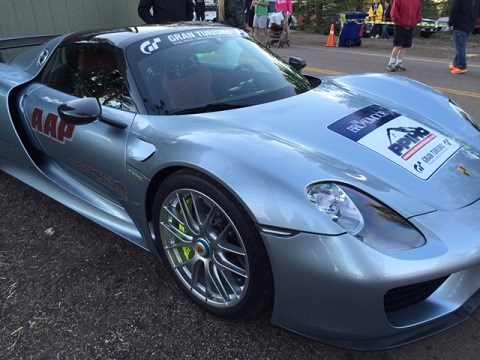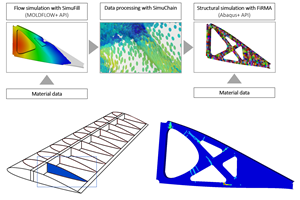Carbon in the cloud(s)
Carbon is the norm, and even a necessity, at the Pikes Peak International Hill Climb race event, held June 28.

An electric race car from Tajima Motor Corp. has an all-carbon composite body and floor. Driven by "Monster" Tajima, it placed second overall in the Pikes Peak International Hill Climb.

My nephew James Robinson's Acura NSX with carbon fiber body, just before his run up the mountain.
I’ve just been writing an article about composite materials for mass production cars (coming in the September issue) and the issues involved in convincing OEMs that composites bring the right value proposition. But, in the midst of that, I got the chance to participate in a motorsports event where carbon fiber composites are the norm, even a necessity, and not the exception: the Pikes Peak International Hill Climb.
Full disclosure: I come from a racing-obsessed family. My Dad, an electrical engineer and sports car enthusiast, used to make extra money fixing those “foreign” jobs during the 50s and 60s that no one else would touch. With Jaguars, MGs, a Morgan and the odd Citroen in the driveway at various times, and our proximity to Watkins Glen, NY and the formula races there, it’s no wonder that Dad, my brother and I eventually wound up racing vintage cars.
Fast forward to the present: my nephews are now all employed by Honda R&D Americas (Raymond, OH, US), and involved in chassis, suspension and engine development for new models, as well as test driving for the company. James Robinson, with a history of rally racing, decided several years ago to bring Honda to the Pikes Peak International Hill Climb, held each year since 1916 on Pike’s Peak near Colorado Springs, CO, US. The objective is to ascend from the start line (at 2889m above sea level) to the 4342m summit on the two-lane paved highway, and negotiate the 156 corners as fast as possible. Check out the official race video on the PPIHC home page: . His brother, Nick Robinson, has lapped the Nurburgring thousands of times during car testing, and he competed at Pikes Peak (and won his class) on a Honda 250 motorcycle.
Over the past three years, Honda’s participation has grown from a few competitors to over 20 cars, motorcycles and four-wheelers. This year a carbon-fiber-bodied 2015 Acura NSX supercar was the designated event pace car (photos of the prototype NSX pace car here: ; a link to a Motor Trend magazine review of the modern NSX: http://www.motortrend.com/future/future_vehicles/1204_2015_acura_nsx/ ; and a photo of the NSX pace car at the Pike’s Peak summit, waiting for all competitors to finish: http://shop.randelsmediagroup.com/p329835694/h4caa68e7#h4cd0a577). As you can see, the weather at the mountain’s summit is a bit of a challenge (it was about 85° at the start line). That pace car was one of several dozen testing prototypes produced by Honda, but James Robinson says that actual production cars will not be all-carbon but will be made using a combination of carbon, steel and aluminum in a multi-material approach. Check out this video of the pace car's run up the mountain: .
A big attraction was the all-electric, carbon-bodied race car with an aluminum chassis built by Tajima Motor Corp. (Tokyo, Japan) and entered as part of the Assn. for the Promotion of Electric Vehicles (APEV). Dubbed the Tajima Rimac E-Runner Concept One, the car was piloted by the head of Tajima Motor Corp, Nobuhiro “Monster” Tajima, a long-time competitor at the event. Due to a mechanical brake failure, Tajima wasn’t the fastest up the mountain, but still managed second place overall, after another electric car. Team APEV crew members told CW that all of the bodywork and the car’s floor panels were fabricated via hand layup and autoclave cure by Monarte, a Tajima subsidiary, using Toho Tenax carbon/epoxy prepreg. Here’s a CW news item about the Team APEV car: http://www.compositesworld.com/news/toho-tenaxs-prepreg-used-in-electric-racecar-.

A carbon fiber-intensive Porsche 918 Spyder supercar was the even'ts second pace car.
Another head-turning entry was a Porsche 918 Spyder supercar piloted by Sheikh Khalid bin Hamad Al-Thani of Qatar (with Qatari plates, and flown in to Colorado). The virtually all-carbon hybrid, with a carbon/epoxy passenger tub and crash structures, produces insane power and speed with a mid-engine V8 coupled with two electric motors. The Sheikh offered a simple explanation to the Colorado Springs Gazette as to why he took on the risk of the hill climb: “I just love racing.” Designated as the second pace car, the Porsche clocked a time of 11 minutes, 37 seconds.
My nephew James Robinson’s car is an original, mid-engined Acura NSX from the 1990s, and is a race-specific version (two such cars were produced) with a carbon fiber body, originally intended for the Le Mans, France endurance race. Modified for the hill climb with a wing, the car and driver managed a second overall in the Open class, with a 10:37 time.
I guess the point here, other than the fact that I got to spend an awesome day at one of the 10 best race events in the world, is that carbon fiber composites have a solid position in motorsports, due to the fact their low weight provides a higher power to weight ratio, which gives you a better chance of winning, and that’s worth the cost of the material. If you’re interested in what it’s like to drive up Pikes Peak, from a driver’s point of view, watch the following video from my nephew’s in-car GoPro camera.
A few notes: you may think the video is distorted or faulty, but you’re seeing the Lexan windshield flexing in the wind at higher speeds. Plus, the noises you’ll notice that sound like gravel are the car’s rear carbon fiber splitter hitting the ground on a few corners. It’s long, but provides a taste of the race to the clouds, in a carbon composite race car (turn up the volume!).
Related Content
McLaren develops aerospace-inspired ART method for volume composite super car engineering
Automated rapid tape (ART) technique, already deployed at the MCTC and to be used for future McLaren models, is capable of producing lighter, stiffer and stronger carbon fiber structures with less waste.
Read MoreCo-molding SMC with braided glass fiber demonstrates truck bed potential
Prepreg co-molding compound by IDI Composites International and A&P Technology enables new geometries and levels of strength and resiliency for automotive, mobility.
Read MoreImproving carbon fiber SMC simulation for aerospace parts
Simutence and Engenuity demonstrate a virtual process chain enabling evaluation of process-induced fiber orientations for improved structural simulation and failure load prediction of a composite wing rib.
Read MoreTPI manufactures all-composite Kenworth SuperTruck 2 cab
Class 8 diesel truck, now with a 20% lighter cab, achieves 136% freight efficiency improvement.
Read MoreRead Next
Cutting 100 pounds, certification time for the X-59 nose cone
Swift Engineering used HyperX software to remove 100 pounds from 38-foot graphite/epoxy cored nose cone for X-59 supersonic aircraft.
Read MoreScaling up, optimizing the flax fiber composite camper
Greenlander’s Sherpa RV cab, which is largely constructed from flax fiber/bio-epoxy sandwich panels, nears commercial production readiness and next-generation scale-up.
Read MoreNext-gen fan blades: Hybrid twin RTM, printed sensors, laser shock disassembly
MORPHO project demonstrates blade with 20% faster RTM cure cycle, uses AI-based monitoring for improved maintenance/life cycle management and proves laser shock disassembly for recycling.
Read More












